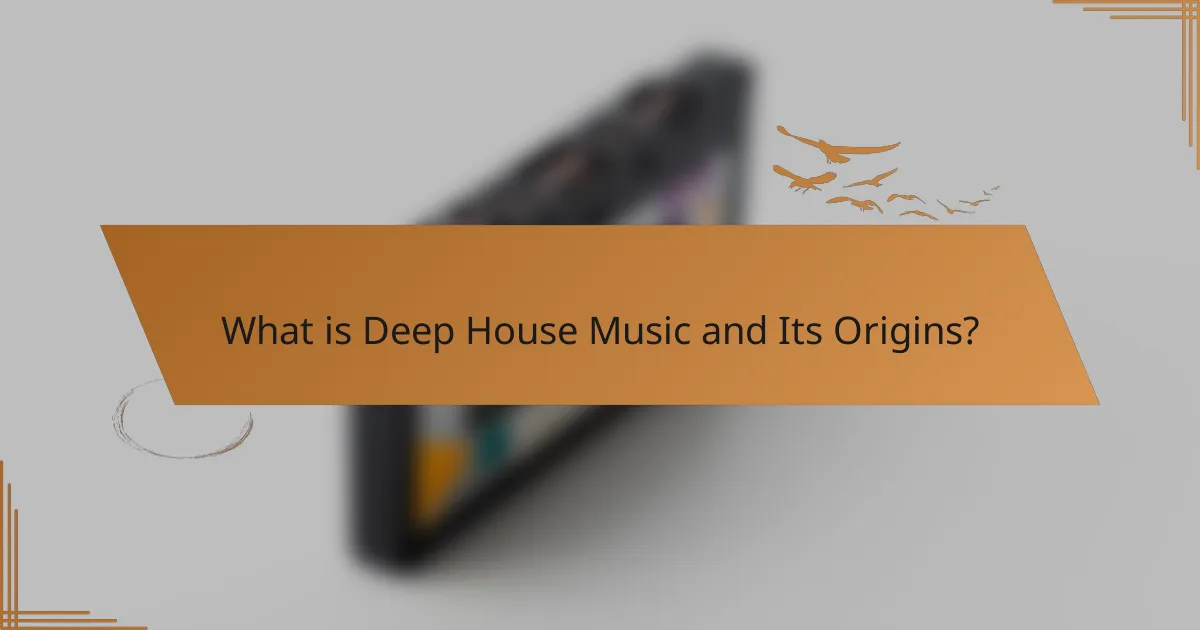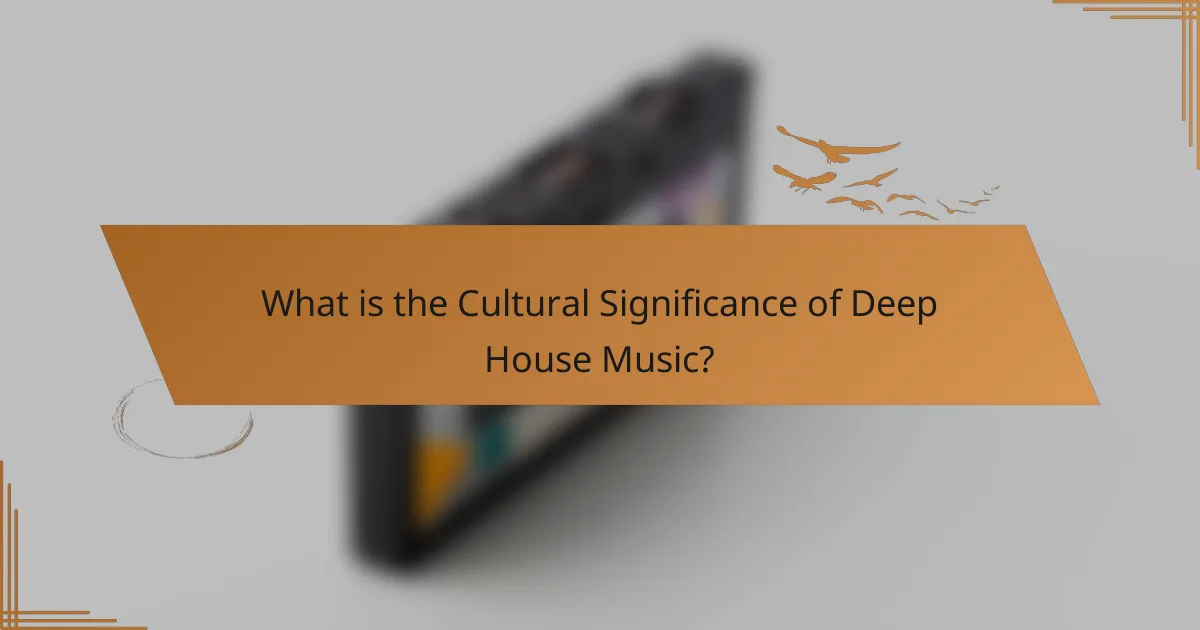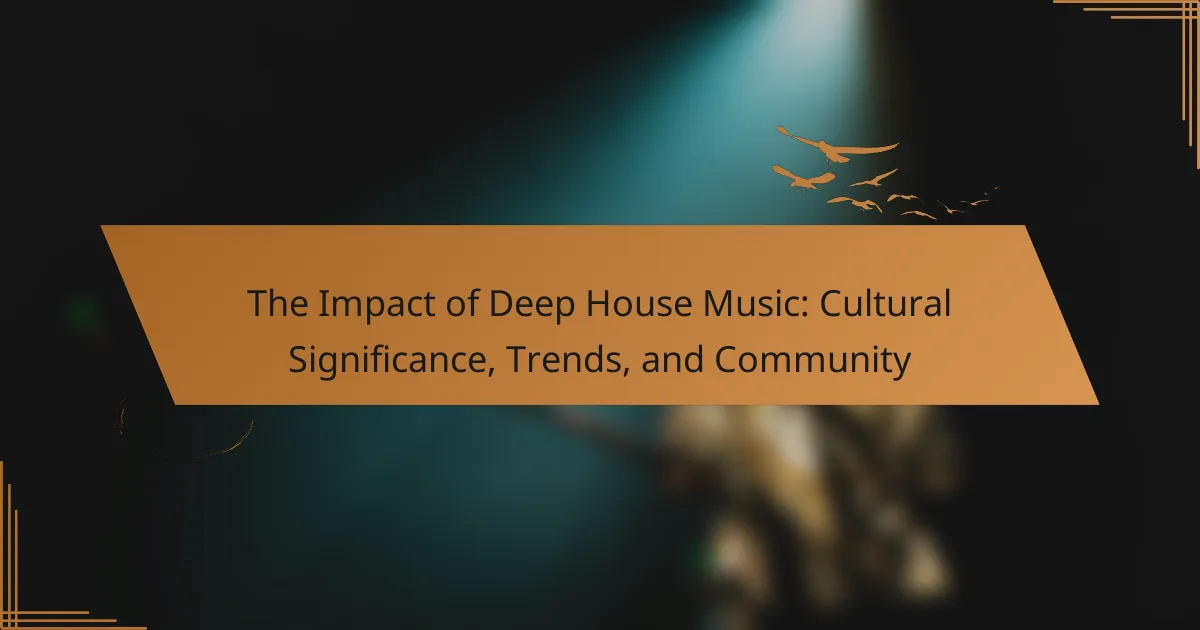Deep house music is a subgenre of house music characterized by its smooth, soulful sound and complex melodies, originating in the 1980s in Chicago. Influenced by jazz, soul, and funk, this genre promotes themes of love, unity, and introspection, fostering a sense of community among listeners. The article explores the cultural significance of deep house music, its evolution, and current trends, including the integration of live instrumentation and the rise of vocal-driven tracks. It also highlights the impact of technology on production and the resurgence of classic house influences, showcasing the genre’s lasting influence on modern electronic dance music and its relevance in contemporary music culture.

What is Deep House Music and Its Origins?
Deep house music is a subgenre of house music known for its smooth, soulful sound and complex melodies. It originated in the 1980s in Chicago, influenced by the city’s vibrant club culture. Pioneers like Larry Heard and Frankie Knuckles played significant roles in shaping its sound. Deep house incorporates elements of jazz, soul, and funk, creating a rich auditory experience. The genre gained popularity in the 1990s in Europe, particularly in the UK and Germany. Its distinct use of basslines and atmospheric pads differentiates it from other house subgenres. Today, deep house music continues to evolve, influencing various artists and genres worldwide.
How did Deep House Music evolve over time?
Deep House Music evolved from the Chicago house scene in the 1980s. It incorporated elements of jazz, soul, and funk. Artists like Larry Heard and Frankie Knuckles were pivotal in its development. The genre gained popularity in clubs, emphasizing a slower tempo and smoother melodies. In the 1990s, it spread to Europe, particularly in the UK and Germany. The use of synthesizers and deep basslines became more prominent during this time. By the 2000s, deep house saw a resurgence with artists like Miguel Migs and Kerri Chandler. The genre continued to evolve, blending with other styles like tech house and minimal techno. Today, deep house is celebrated for its emotional depth and rich soundscapes.
What are the key influences that shaped its sound?
Deep house music is shaped by several key influences. Its sound is rooted in Chicago house music from the 1980s. This genre incorporated elements of jazz, soul, and funk. The use of smooth, melodic basslines is a significant characteristic. Vocals often draw from R&B and gospel traditions, adding emotional depth. The influence of Detroit techno also contributes to its rhythmic complexity. Additionally, deep house incorporates ambient music elements, creating atmospheric soundscapes. These influences combine to define the rich, layered sound of deep house music.
How do cultural contexts contribute to its development?
Cultural contexts significantly shape the development of deep house music. The genre emerged in the 1980s in Chicago, influenced by the city’s diverse musical heritage. This includes elements from disco, jazz, and soul music. The cultural backdrop provided a unique sound that resonated with local communities.
Deep house music also reflects social movements and cultural shifts. For instance, it often addresses themes of love, unity, and community. The genre’s evolution is linked to the rise of underground dance culture. This culture fosters inclusivity and collective experiences.
Moreover, cultural contexts influence the production and consumption of deep house music. Different regions add their own flavors, creating diverse sub-genres. For example, European cities like Berlin have contributed a darker, more minimalistic sound.
In summary, cultural contexts are essential in shaping the sound, themes, and community aspects of deep house music.
What are the defining characteristics of Deep House Music?
Deep House Music is characterized by its smooth, soulful sound and deep basslines. The genre typically features a tempo range of 120 to 125 beats per minute. It often incorporates elements of jazz, funk, and soul music. Vocals in Deep House tend to be soft and melodic. The use of atmospheric pads and synths creates a lush soundscape. Additionally, Deep House often includes sampled sounds from various genres. The genre emerged in the 1980s and has roots in Chicago house music. Its influence can be seen in various contemporary music styles.
What instruments and production techniques are commonly used?
Deep house music commonly uses synthesizers, drum machines, and samplers. Key instruments include the Roland TR-808 and TR-909 drum machines. Synthesizers like the Moog Minimoog and Korg MS-20 are frequently utilized. Production techniques often involve layering sounds and using reverb effects. Producers typically apply sidechain compression to create a pulsing effect. Additionally, vocal samples and ambient pads are prevalent in deep house tracks. The genre emphasizes groove and rhythm, often incorporating elements of jazz and soul. These characteristics define the unique sound of deep house music.
How does Deep House differentiate itself from other electronic genres?
Deep House differentiates itself from other electronic genres through its unique sound and characteristics. It features a slower tempo, typically ranging from 120 to 125 BPM. Deep House incorporates soulful vocals and rich, melodic elements. The genre often uses jazzy chords and atmospheric textures. Unlike genres like Techno or Trance, Deep House emphasizes groove and emotional depth. This style creates a more laid-back listening experience. Its roots trace back to the Chicago house scene of the 1980s. The genre has evolved while maintaining its distinct identity within the electronic music landscape.

What is the Cultural Significance of Deep House Music?
Deep house music holds significant cultural value as it blends elements of jazz, soul, and funk. This genre emerged in the 1980s in Chicago, influencing club culture globally. Its soothing melodies and deep basslines foster a sense of community and connection among listeners. Deep house often promotes themes of love, unity, and introspection. The genre has been pivotal in shaping modern electronic dance music. It has influenced various artists and genres, creating a lasting impact on music trends. Festivals and events dedicated to deep house celebrate its cultural importance. The genre continues to evolve while maintaining its core values of inclusivity and emotional expression.
How does Deep House Music influence social movements?
Deep House music influences social movements by providing a platform for expression and community building. Its rhythmic and soulful sound fosters a sense of unity among diverse groups. This genre often addresses themes of love, social justice, and empowerment in its lyrics. Events like music festivals and club nights serve as gatherings for activism and awareness. Historical examples include the role of House music in the [censured] rights movement during the 1980s. The genre’s roots in marginalized communities highlight its potential for social change. Studies show that music can enhance collective identity and motivate action. Thus, Deep House music acts as a catalyst for social movements through cultural resonance and community engagement.
What role does it play in promoting inclusivity and diversity?
Deep house music plays a significant role in promoting inclusivity and diversity. It fosters a sense of community among diverse groups. The genre originated from various cultural influences, including African American, Latino, and European music traditions. This blend encourages collaboration among artists from different backgrounds. Events featuring deep house music often attract a mixed audience, promoting social interaction. Statistics show that music festivals highlighting deep house have increased attendance from underrepresented communities. Additionally, deep house lyrics often emphasize themes of unity and acceptance. This further reinforces its role in encouraging a more inclusive environment.
How does Deep House reflect contemporary societal issues?
Deep House reflects contemporary societal issues through its themes and community engagement. The genre often addresses topics such as identity, belonging, and social justice. Lyrics frequently explore personal struggles, mental health, and relationships. This resonates with listeners facing similar challenges in modern society. Additionally, Deep House events foster inclusivity and diversity, promoting social connections among varied demographics. The genre’s evolution mirrors shifts in cultural attitudes and technological advancements. For example, the rise of streaming platforms has democratized access to music, reflecting broader societal changes in consumption. Overall, Deep House serves as a sonic representation of contemporary life and its complexities.
What impact does Deep House Music have on local communities?
Deep House Music positively impacts local communities by fostering social connections and cultural expression. It creates spaces for people to gather, dance, and share experiences. Events featuring Deep House often promote inclusivity and diversity, welcoming individuals from various backgrounds. This genre encourages local artists and DJs, boosting the local music scene. Studies show that music events can enhance community cohesion and reduce social isolation. Additionally, Deep House venues can stimulate local economies through increased foot traffic and tourism. Overall, Deep House Music serves as a catalyst for community engagement and cultural vibrancy.
How do local scenes shape the sound and culture of Deep House?
Local scenes significantly shape the sound and culture of Deep House. Each scene brings unique influences that define its musical style. Local artists often incorporate regional sounds and instruments. This results in diverse sub-genres within Deep House. For example, Berlin’s scene emphasizes minimalistic beats. In contrast, Chicago’s roots reflect soulful vocal elements. Local venues also influence the culture, creating spaces for community engagement. The interaction among local DJs, producers, and audiences fosters a distinct atmosphere. This dynamic exchange cultivates a rich cultural identity within the Deep House genre.
What are the economic benefits of Deep House events in communities?
Deep House events provide significant economic benefits to communities. They stimulate local economies by attracting visitors who spend on accommodations, dining, and entertainment. According to a study by the National Endowment for the Arts, cultural events can generate substantial revenue for local businesses. These events also create job opportunities in event management, hospitality, and security. Additionally, they enhance community engagement and promote local artists, which can lead to increased tourism. The presence of such events can elevate the community’s profile, making it more attractive for future investments. Overall, Deep House events contribute to economic growth and community development.

What are the Current Trends in Deep House Music?
Current trends in deep house music include the integration of live instrumentation. Artists are increasingly blending electronic sounds with acoustic elements. This creates a richer auditory experience. Another trend is the rise of vocal-driven tracks. Collaborations with soulful and R&B vocalists are becoming popular. The genre is also seeing a resurgence of classic house influences. Producers are incorporating elements from the 90s house music scene. Additionally, there is a focus on deeper, more atmospheric soundscapes. This trend emphasizes emotional resonance and immersive listening. Finally, the use of technology in production is evolving. Tools like AI and advanced software are shaping new sounds in deep house music.
How is technology influencing Deep House Music production?
Technology is significantly influencing Deep House Music production by enhancing accessibility and creativity. Digital Audio Workstations (DAWs) allow producers to create, edit, and mix music with ease. Software synthesizers and plugins provide a wide range of sounds and effects. This technology enables experimentation with unique sounds and textures. Additionally, online platforms facilitate collaboration among artists worldwide. Sampling technology allows producers to incorporate diverse musical elements seamlessly. The rise of affordable music production tools democratizes the industry, enabling more artists to enter the scene. These advancements contribute to the evolving sound of Deep House Music.
What new tools and software are artists using today?
Artists today are using innovative tools and software like Procreate, Adobe Fresco, and Blender. Procreate is a powerful digital illustration app popular among illustrators. Adobe Fresco offers advanced painting and drawing capabilities, especially for those who prefer a natural feel. Blender is widely used for 3D modeling and animation, providing artists with extensive creative options. Additionally, software like Ableton Live and FL Studio is gaining traction among music producers for their user-friendly interfaces and robust features. These tools enhance creativity and streamline artistic workflows.
How is the rise of streaming platforms changing the landscape?
The rise of streaming platforms is significantly altering the music landscape. These platforms provide unprecedented access to a vast array of music genres, including deep house. Artists can now reach global audiences without traditional gatekeepers like record labels. This democratization of music distribution allows for diverse sounds and styles to flourish. Streaming services also enable data-driven insights into listener preferences. As a result, artists can tailor their content to meet audience demands more effectively. Additionally, the rise of playlists has shifted how music is consumed, favoring single tracks over full albums. This change impacts how artists approach music creation and marketing. Overall, streaming platforms are reshaping the relationship between artists and audiences, fostering a more interactive and immediate music experience.
What are the popular themes and styles in contemporary Deep House?
Contemporary Deep House features themes of emotion, introspection, and atmosphere. These themes often emphasize soulful melodies and complex harmonies. The style blends elements of jazz, funk, and soul. It frequently incorporates smooth basslines and rhythmic percussion. Vocals in contemporary Deep House are often soft and ethereal. This creates a dreamy soundscape that enhances emotional depth. Additionally, the genre embraces influences from tech house and minimal house. This fusion results in a diverse range of sounds and textures. Popular artists often experiment with these elements, pushing the boundaries of traditional Deep House.
How do current musical trends reflect broader cultural shifts?
Current musical trends, including deep house music, reflect broader cultural shifts by mirroring societal values and technological advancements. For instance, the rise of deep house music emphasizes inclusivity and community engagement. This genre often features diverse artists and promotes collaboration across cultures. Additionally, the prevalence of digital platforms has democratized music production and distribution. This shift allows independent artists to reach global audiences without traditional gatekeepers. Moreover, deep house music often incorporates social themes, addressing issues like mental health and urban life. These themes resonate with younger generations seeking authenticity and connection. Overall, musical trends serve as a lens through which cultural dynamics can be observed and understood.
What are the emerging artists and labels to watch in Deep House?
Emerging artists to watch in Deep House include Tibi Dabo, who is known for his innovative sound. Another notable artist is Kettama, recognized for his energetic tracks. For labels, look out for Shall Not Fade, which has gained attention for its quality releases. Additionally, Anjunadeep continues to support fresh talent in the genre. These artists and labels are shaping the future of Deep House music. Their unique styles and contributions are gaining traction in the music community.
How can listeners engage with the Deep House community?
Listeners can engage with the Deep House community through various platforms and activities. They can participate in online forums and social media groups dedicated to Deep House music. Events such as local club nights and music festivals provide opportunities for in-person interaction. Streaming platforms often host live DJ sets where listeners can connect with artists and other fans. Engaging with music blogs and podcasts focused on Deep House can enhance their understanding and appreciation of the genre. Additionally, listeners can support artists by purchasing music and merchandise. These actions foster a sense of belonging within the community.
What are the best practices for discovering new Deep House music?
Follow these best practices to discover new Deep House music. Explore online music platforms like SoundCloud and Mixcloud. These platforms feature emerging artists and curated playlists. Join Deep House communities on social media. Engage with groups on Facebook and Reddit for recommendations. Attend local music events and festivals. Live performances often showcase new talent. Utilize music discovery apps like Shazam and Spotify. These apps can identify songs and suggest similar tracks. Listen to Deep House radio stations online. Many stations focus on new releases and underground sounds. Subscribe to music blogs and newsletters. They often highlight new artists and tracks in the genre.
How can fans support their favorite Deep House artists and events?
Fans can support their favorite Deep House artists and events by purchasing their music and merchandise. This financial support helps artists sustain their careers. Attending live events and festivals also boosts visibility and revenue for the artists. Fans can promote artists through social media, sharing their tracks and events. Engaging in online communities dedicated to Deep House fosters a supportive network. Leaving positive reviews and ratings on platforms enhances the artist’s reputation. Collaborating with local venues to host events can increase exposure. Supporting crowdfunding campaigns for projects provides artists with necessary resources. Each action contributes to the overall growth and sustainability of the Deep House scene.
Deep house music is a subgenre of house music known for its smooth, soulful sound and complex melodies, originating in the 1980s in Chicago. This article explores deep house’s cultural significance, its evolution over time, key influences, and defining characteristics, as well as its impact on local communities and social movements. It also examines current trends, technological advancements in production, and emerging artists and labels within the genre. Additionally, the article highlights how listeners can engage with the deep house community and support their favorite artists and events.
